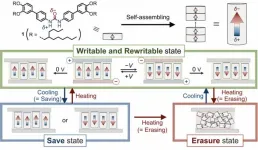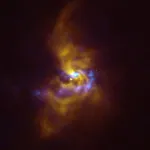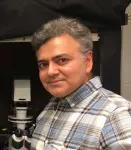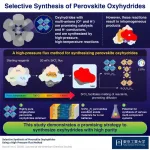In today’s world of digital information, an enormous amount of data is exchanged and stored on a daily basis. In the 1980s, IBM unveiled the first hard drive—which was the size of a refrigerator—that could store 1 GB of data, but now we have memory devices that have a thousand-fold greater data-storage capacity and can easily fit in the palm of our hand. If the current pace of increase in digital information is any indication, we require yet newer data recording systems that are lighter, have low environmental impact, and, most importantly, have higher data storage density.
Recently, a new class of materials called axially polar-ferroelectric columnar liquid crystals (AP-FCLCs) has emerged as a candidate for future high-density memory storage materials. An AP-FCLC is a liquid crystal with a structure of parallel columns generated by molecular self-assembly, which have polarization along the column axis. The columns switch their polar directions upon the application of an external electric field. If AP-FCLCs can maintain their polarization even after the electric field is removed, this property, along with their flexibility, metal-free composition, power-saving ability, and low environmental impact, makes AP-FCLCs ideal for ultra-high-density memory devices. Unfortunately, due to the fluid nature of liquid crystals, the polarity induced by an external electric field can get easily undone by external stimuli.
A solution to this problem has now been proposed by a team of researchers from Chiba University, led by Professor Keiki Kishikawa of the Graduate School of Engineering and including Doctoral Course student Hikaru Takahashi of the Graduate School of Science and Engineering and Associate Professor Michinari Kohri of the Graduate School of Engineering. In their recent breakthrough study, made available online on June 12, 2023, and published in Volume 6, Issue 12 of ACS Applied Nano Materials on June 23, 2023, the team presented a polarization fixation mechanism for a urea-based AP-FCLC system, where the materials can undergo a smooth transition from AP-FCLC phase to a crystal (Cr) phase without affecting the induced polar structure.
“The goal was to realize a compound with three states: a writable and rewritable state, an erasure state, and a save state. Emphasis was placed on minimizing the change in molecular packing structures during the FCLC−Cr phase transition process,” explains Prof. Kishikawa.
To create a polarization-fixable AP-FCLC system, the team synthesized 1,3-bis(3’,4’-di(2-butyloctyloxy)[1,1’-biphenyl]-4-yl)urea—an organic molecule consisting of urea at its molecular center for generating a hydrogen bonding network that can facilitate the formation of columnar aggregate in a liquid crystal (LC) state, two biphenyl groups as substituents for generating strong intermolecular interactions in the column structure, and four bulky alkyl groups as terminal chains to prevent tight molecular packing and enable lower-temperature FCLC−Cr phase transition.
The prepared FCLC system exhibited preservation of polarization in the Cr phase, with thermally stable polarization information storage and resistance to the external electrical field at room temperature. Furthermore, we found that the molecules self-sorted into nanosized helical columns, which then formed small domains and became ferroelectric in nature.
This study provides a new strategy for the development of AP-FCLC systems that can maintain their polarization information for a long time. The proposed framework can be used to develop stable memory materials with high tolerance towards external stimuli and low environmental impact. “AP-FCLCs have the potential to achieve more than 10,000 times larger recording density than Blu-ray Discs, but they have not been put into practical use due to the instability issue. This work will help improve their reliability, paving the way for light-weight flexible electronic devices and incinerable confidential information-recording devices,” concludes Prof. Kishikawa.
With these new liquid crystals, the future of memory storage looks secure!
About Professor Keiki Kishikawa from Chiba University
Dr. Keiki Kishikawa is a Professor at the Graduate School of Engineering at Chiba University, Japan. He received his bachelor’s and master’s degrees in Industrial Chemistry from Chiba University, followed by a doctoral degree in Mathematics and Materials Sciences. His current areas of research interest include nanostructures, ferroelectrics, materials chemistry, and liquid crystals. He has published over 200 research articles, which have been cited more than 4,500 times. He was awarded the JLCS Award for Outstanding Achievement from The Japanese Liquid Crystal Society in 2021.
END
A nano switchable polar column system that allows high-density data storage
Scientists have developed a new urea-based metal-free system that can improve data storage in devices
2023-07-25
(Press-News.org)
ELSE PRESS RELEASES FROM THIS DATE:
New image reveals secrets of planet birth
2023-07-25
A spectacular new image released today by the European Southern Observatory gives us clues about how planets as massive as Jupiter could form. Using ESO’s Very Large Telescope (VLT) and the Atacama Large Millimeter/submillimeter Array (ALMA), researchers have detected large dusty clumps, close to a young star, that could collapse to create giant planets.
“This discovery is truly captivating as it marks the very first detection of clumps around a young star that have the potential to give rise to giant planets,” says Alice Zurlo, a researcher at the Universidad Diego Portales, Chile, involved ...
UBC researchers recover vital resources from wastewater sludge
2023-07-25
If you were ever to see sewage sludge up close, you might be hard-pressed to find any redeemable value; however, researchers at UBC’s Bioreactor Technology Group see it another way.
Using a combination of heat, water and phase separation, UBC researchers have developed a cost-effective method to concentrate phosphorous—which can be efficiently recovered by extraction—from wastewater sludge.
“Phosphorous is a non-renewable, but essential, element for life and has many industrial uses,” explains Huan Liu, a doctoral student with UBCO’s School of Engineering and lead author of a new study investigating ...
A new vision for US health care
2023-07-25
It’s not exactly what he’s best known for, but Alexander Hamilton helped develop the first national, compulsory health insurance policy in the world: a 1798 taxpayer-financed plan Congress approved to cover sick and disabled seamen.
“The interests of humanity are concerned in it,” Hamilton wrote.
And they still are, as MIT Professor Amy Finkelstein notes in a new book. The U.S. has repeatedly tried to provide medical care for those who need it and cannot afford it. These efforts may have started with Hamilton, but ...
Inflammation discovery could slow aging, prevent age-related diseases
2023-07-25
University of Virginia School of Medicine researchers have discovered a key driver of chronic inflammation that accelerates aging. That finding could let us slow the clock to live longer, healthier lives, and may allow us to prevent age-related conditions such as deadly heart disease and devastating brain disorders that rob us of our faculties.
So what drives this harmful inflammation? The answer is improper calcium signaling in the mitochondria of certain immune cells. Mitochondria are the power generators in all cells, ...
UK and Europe join forces for construction of largest ever European Solar Telescope
2023-07-25
**Images available**
Nine European countries, including the UK, have today (25 July 2023) joined forces to commit to the construction of the European Solar Telescope (EST)
The EST will be the biggest solar telescope ever constructed in Europe and aims to provide unparalleled new insights into the phenomena of space weather
The University of Sheffield will lead a consortium of UK universities that will help to develop designs for the construction of the large-aperture solar telescope
The first light of the EST is ...
PSMA PET imaging improves accuracy of predicting prostate cancer recurrence
2023-07-25
A molecular imaging tool developed by researchers at the University of California’s two nationally ranked medical centers, UCLA and UCSF, helps improve the accuracy of predicting the risk of cancer recurrence in patients with intermediate to high-risk prostate cancer who undergo surgery.
The tool, known as prostate-specific membrane antigen PET imaging, or PSMA PET, provides prognostic information before treatment begins that can predict if the patient will have a high risk for the cancer returning after surgery.
“In patients ...
All US racial and ethnic minority groups are underrepresented in Alzheimer’s neuroimaging research, study shows
2023-07-25
Alzheimer’s disease (AD), which affects an estimated 6.5 million adults in the United States, hits some groups harder than others. Compared to non-Hispanic whites, Hispanic Americans are 1.5 times as likely to develop AD, and African Americans are twice as likely.
But scientists know little about the reasons behind these disparities, because the vast majority of AD research has been done with non-Hispanic white people.
A new study that reviewed 11,871 research articles on AD brain imaging, led by researchers at the Keck School of Medicine of USC, has now revealed the extent of ...
84% cut in Covid deaths for UK cancer patients following vaccine rollout
2023-07-25
Cancer patients saw a significant fall in Covid-related hospitalisations and mortality following the rollout of vaccines in the first panoramic study of its kind.
The research published in Scientific Reports today (Tuesday 25 July) looked at the impact of the global pandemic on case-outcome rates for cancer patients across a 21-month period from November 2020 to August 2022. The team of researchers led by the University of Birmingham found that hospitalisations in the period fell from nearly one in three patients (30.58%) to one in 13 patients (7.45%); and, case-mortality rates fell from more than one in five patients (20.53%) to less than one in 30 patients (3.25%).
Among ...
A chance to design better vaccines?
2023-07-25
A new paper in Biology Methods & Protocols, published by Oxford University Press, shows it may be possible to design vaccines that will induce a stronger immune response to infecting pathogens, such as the virus causing COVID-19. In this study, the authors proposed and tested a new bioinformatic approach and tool that allows researchers to select parts of proteins that will elicit a strong immune response. Vaccines developed based on this approach would provide better protection from diseases.
The immune system of humans (and other vertebrates) discriminates between self and non-self structures to attack and destroy the latter. T cells are the part of the immune system ...
A high-pressure flux method to synthesize high-purity oxyhydrides
2023-07-25
Adding a flux during the synthesis of oxyhydrides is a promising strategy to obtain a pure, homogenous product, reveal scientists from Tokyo Tech. An SrCl2 flux promoted the melting of a part of reactants and facilitated their diffusion of reactants, which proved to be the key to producing highly pure SrVO2.4H0.6 or Sr3V2O6.2H0.8 perovskite oxyhydrides in high-pressure and high-temperature reactions. These compounds have potential as catalysts and as electrode materials for lithium-ion batteries.
Perovskite oxyhydrides ...
LAST 30 PRESS RELEASES:
World-first discovery uncovers how glioblastoma tumours dodge chemotherapy, potentially opening the door to new treatments
A fatal mix-up: How certain gut bacteria drive multiple sclerosis
New AI tool identifies not just genetic mutations, but the diseases they may cause
Deep-learning model predicts how fruit flies form, cell by cell
Combination pills for high blood pressure may simplify treatment, improve long-term health
Immune system keeps mucosal fungi in check
Neurons within the brain use simple rules to localize genetic messages
Electrodes created using light
Second-hand gift-giving is a well-deliberated decision
How human interaction drove evolution to make bears less aggressive
National Poll: Few parents offer teens guidance on healthy eating during holiday season
Cannabis derivatives could provide new ovarian cancer treatments
Raising strong yeast as a petroleum substitute
Clues to the origin of hot Jupiters hidden in their orbits
Canada’s reduced pledge to Global Fund will impact domestic health
1 in 4 children with major traumatic injuries not cared for in pediatric trauma centres
Duke and Duke-NUS’ joint cross-population research to uncover "East-West" differences in disease and care
Scientists to ‘spy’ on cancer- immune cell interactions using quantum technology breakthrough
Tech savvy users have most digital concerns
Making lighter work of calculating fluid and heat flow
Normalizing blood sugar can halve heart attack risk
Lowering blood sugar cuts heart attack risk in people with prediabetes
Study links genetic variants to risk of blinding eye disease in premature infants
Non-opioid ‘pain sponge’ therapy halts cartilage degeneration and relieves chronic pain
AI can pick up cultural values by mimicking how kids learn
China’s ecological redlines offer fast track to 30 x 30 global conservation goal
Invisible indoor threats: emerging household contaminants and their growing risks to human health
Adding antibody treatment to chemo boosts outcomes for children with rare cancer
Germline pathogenic variants among women without a history of breast cancer
Tanning beds triple melanoma risk, potentially causing broad DNA damage
[Press-News.org] A nano switchable polar column system that allows high-density data storageScientists have developed a new urea-based metal-free system that can improve data storage in devices




